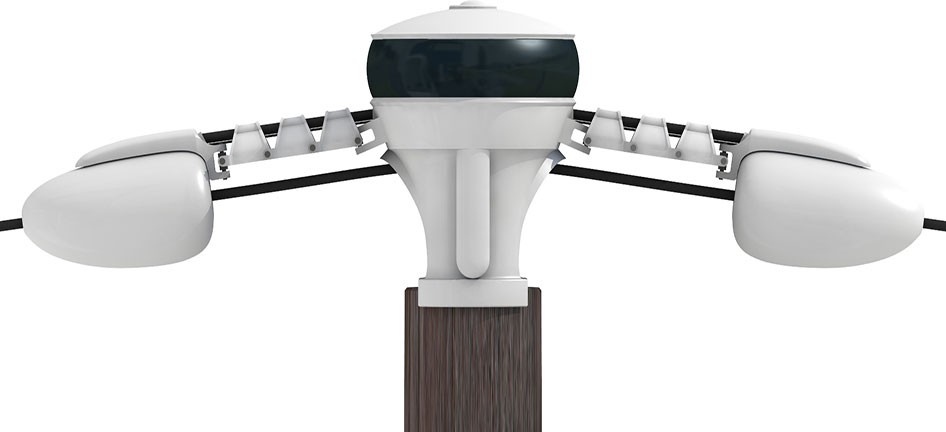AT&T in Advanced Discussions with Power Companies and Others to Trial Project AirGig
Project AirGig and Other AT&T Access Technologies Bring Faster Connectivity to Customers Anywhere
AT&T* is in advanced discussions with power companies and others to trial Project AirGig in at least two locations by this fall. One location will be in the United States with others to be determined in the coming months.
AT&T has experimented with this unique, patented broadband-over-power lines (BPL) technology at our outdoor facility for some time with positive results. These results led to our development of new innovations like the Radio Distributed Antenna System (RDAS). Now, we’re closer to taking our trials to the next level.
“We are looking forward to begin testing the possibilities of AT&T Labs’ invention for customers and utility companies,” said Andre Fuetsch, president of AT&T Labs and chief technology officer. “AT&T is focused on delivering a gigabit-per-second speed everywhere we can with our wired and wireless technologies. Project AirGig represents a key invention in our 5G Evolution approach. AT&T Labs is ‘writing the textbook’ for a new technology approach that has the potential to deliver benefits to utility companies and bring this multi-gigabit, low-cost internet connectivity anywhere there are power lines – big urban market, small rural town, globally.”
In the last several years, we’ve seen staggering usage growth on our wireless network – data has increased about 250,000% since 2007, and the majority of that traffic is video. This trend is not going to stop, with the rise of 4K mobile video streaming, augmented and virtual reality, smart homes and cities, autonomous vehicles and more. And we’re working to provide connectivity everywhere, so our customers can enjoy these technologies seamlessly, wherever they are.
Early this year, we provided an outlook on our 5G Evolution and other initiatives to provide ultra-fast Internet access. We’re working to develop and enhance several access technologies.
Project AirGig Progress
More than 10 years ago, some AT&T Labs engineers worked on earlier experiments to deliver BPL. Back then, broadband merely meant megabit speeds. The technology worked well, but couldn’t keep up with the move to higher speeds.
So, our engineers shifted their focus from BPL to millimeter wave (mmWave) technology, and became curious about combining mmWave and powerlines. No one in the industry had connected these technologies together yet.
Some of the first experiments involved transmitting data signals using funnels from a local auto parts store covered with aluminum foil, placed next to unenergized power cables. These tests produced unexpected positive results, creating the foundation of Project AirGig’s development – transporting mmWaves over powerlines.
Now, we have more than 200 patents and patent applications for Project AirGig. AT&T Labs engineers and scientists invented low-cost plastic antennas, a Radio Distributed Antenna System (RDAS), mmWave surface wave launchers and inductive power devices. The RDAS will reconstruct signals for multi-gigabit mobile and fixed deployments. A typical DAS carries cellular signals throughout buildings and stadiums, using fiber and/or coaxial cables to transmit analog signals.
With the RDAS, we found a system design to effectively deliver not just broadband, but also mobile traffic. The mmWave surface wave launchers and inductive power devices can power themselves without a direct electrical connection. These devices create a multi-gigabit signal that travels along or near the wire – not through it. This signal means connected experiences become an everyday reality for people – regardless of location.
About AT&T
AT&T Inc. (NYSE:T) helps millions around the globe connect with leading entertainment, mobile, high speed internet and voice services. We’re one of the world’s largest providers of pay TV. We have TV customers in the U.S. and 11 Latin American countries. We offer the best global coverage of any U.S. wireless provider.* And we help businesses worldwide serve their customers better with our mobility and highly secure cloud solutions.
Additional information about AT&T products and services is available at http://about.att.com. Follow our news on Twitter at @ATT, on Facebook at http://www.facebook.com/att and YouTube at http://www.youtube.com/att.
© 2017 AT&T Intellectual Property. All rights reserved. AT&T, the Globe logo and other marks are trademarks and service marks of AT&T Intellectual Property and/or AT&T affiliated companies. All other marks contained herein are the property of their respective owners.
*Global coverage claim based on offering discounted voice and data roaming; LTE roaming and voice roaming in more countries than any other U.S. based carrier. International service required. Coverage not available in all areas. Coverage may vary per country and be limited/restricted in some countries.
Cautionary Language Concerning Forward-Looking Statements
Information set forth in this news release contains financial estimates and other forward-looking statements that are subject to risks and uncertainties, and actual results might differ materially. A discussion of factors that may affect future results is contained in AT&T’s filings with the Securities and Exchange Commission. AT&T disclaims any obligation to update and revise statements contained in this news release based on new information or otherwise.



Whether in a big city or rural town, things like 4K mobile video streaming, virtual reality and smart cities become possible.
These antennas and devices along power lines effectively deliver broadband and mobile traffic. No need to build new towers. No need to bury new cables in the ground.
Future field trials will demonstrate how Project AirGig works to support power companies’ smart grid technologies, such as meter, appliance and usage control systems and early detection of powerline integrity issues. The trials will also evaluate the technology during inclement weather, such as rain, snow and high winds. Importantly, we can more precisely determine the cost of deployment while maintaining the highest signal quality for a customer.
AT&T Fiber
We continue to expand access to our fastest wired internet speeds. Today, we’re marketing a 1 gigabit connection** on our 100% fiber network to nearly 4 million locations across 46 metros nationwide. More than 650,000 of these locations include apartments and condo units.
A higher percentage of customers in metros where we offer our 100% fiber network subscribe to internet service from AT&T compared to metros where we do not yet offer this network. Customers in these metros can choose from a wide range of internet speed plans, with about half of our new internet customers subscribing to AT&T Internet 100 or higher, and 30% of those subscribing to AT&T Internet 1000.
We also provide customers an integrated communications and entertainment experience by offering home internet, TV, phone and mobility services from a single provider. The vast majority of fourth quarter 2016 fiber and TV sales in areas where we offer our 100% fiber network chose multiple services from AT&T.
We have the largest fiber network across the 21 states where we offer home internet service. By mid-2019 we plan to reach at least 12.5 million locations across 67 metro areas with our 100% fiber network.
5G & Small Cells Innovation
We’ve started deploying small cells using Centralized RAN (C-RAN) architecture in the city of San Francisco. This deployment, which will be replicated in other cities, will densify our network and lay the groundwork for 5G and beyond. Additionally, we have entered into an agreement to acquire FiberTower Corporation, and its mmWave spectrum rights, to assist in the execution of this vision.
We plan to install small cells on light posts and other infrastructure in the urban core of San Francisco. We’ll use a C-RAN architecture approach to build them. That means all the “brains” or base band units of each small cell or tower will exist in one location.
Storing the brains of hundreds of towers and small cells in one place lets engineers add capacity and improve efficiency for hundreds of cell sites quickly and simultaneously. New features may include smart city applications or network upgrades. Putting the hardware in one location will also make it easier to transition to cloud and software-based technology, which aligns with the AT&T 2020 vision and software-defined networking.
Additional Connectivity Trials
We’re continuing additional efforts to turn today’s copper lines into fiber-like speeds and deliver faster internet in rural areas with slow or no internet connectivity.
G.fast technology enables us to bring the speed of fiber to existing copper lines that already exist in many locations. Based on the learnings of a G.fast trial at a multifamily property in Minneapolis, we plan to make the technology available at additional locations beginning mid-2017.
In 2016, we began trialing a Fixed Wireless Internet (FWI) service in several states on our path to expand access to locations with slow or no internet connectivity - primarily in rural areas - as part of our participation in the FCC Connect America Fund (CAF).
We plan to begin offering FWI in areas where we accepted CAF support in mid-2017, reaching over 400,000 locations by the end of this year. Ultimately we plan to expand internet access to more than 1.1 million locations across 18 states by the end of 2020.
*AT&T products and services are provided or offered by subsidiaries and affiliates of AT&T Inc. under the AT&T brand and not by AT&T Inc.
** Actual customer speeds may vary. Download speeds are typically up to 940Mbps due to overhead capacity reserved to deliver the data.
Double click to select the video





